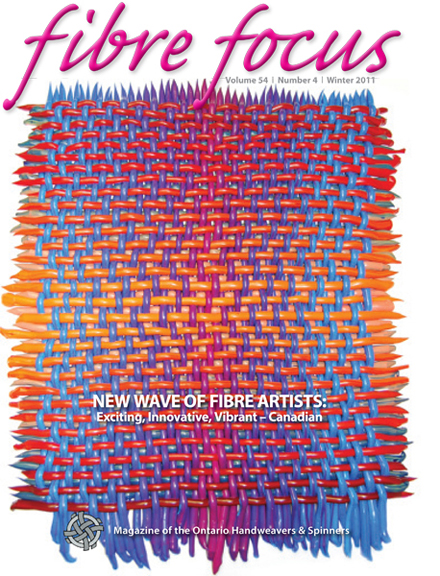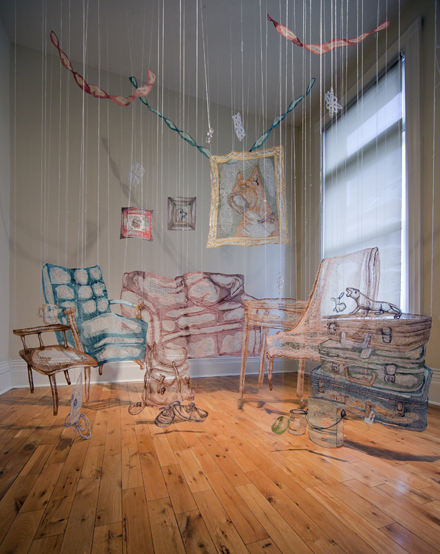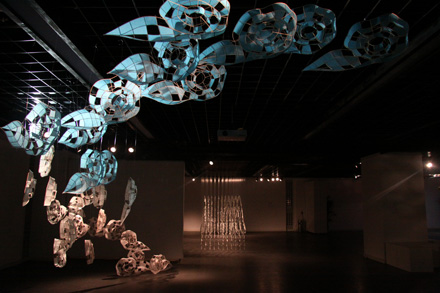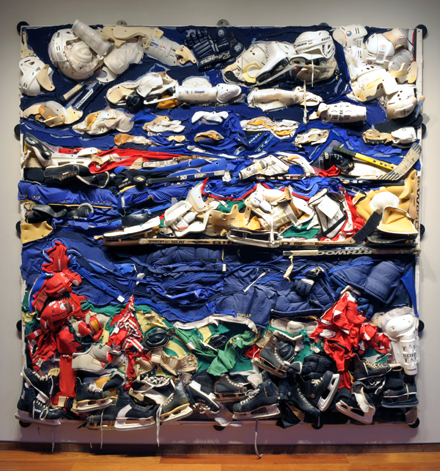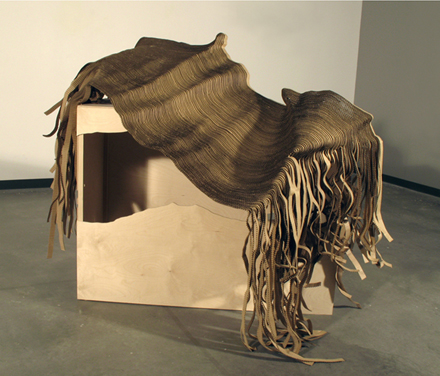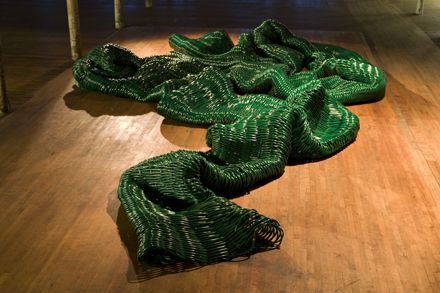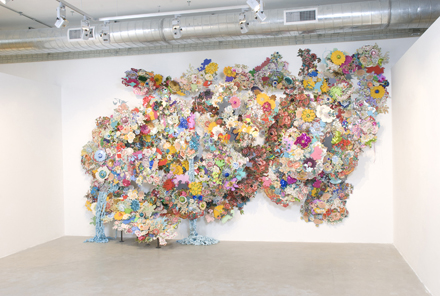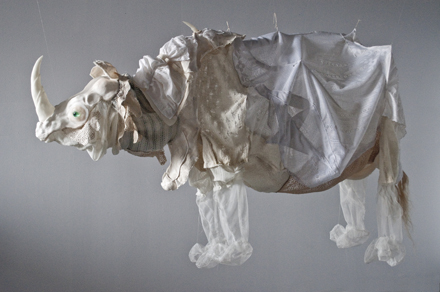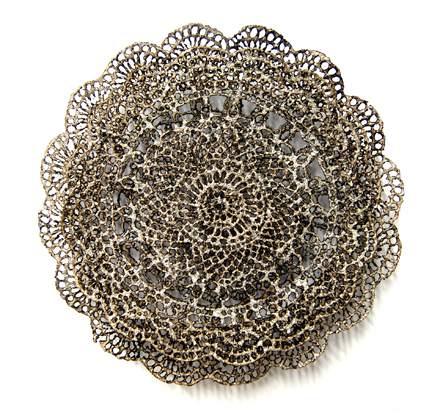Ten Up and Coming
Canadian Fibre Artists to Watch
Gareth Bate
Published:
Fibre Focus Magazine
Winter Part 1: Jan. 2012, Spring Part 2: April 2012
Return to Writing Menu
Quick Links: Amanda McCavour | Xiaojing Yan | Liz Pead | Elisabeth Picard | Robert Davidovitz | Gareth Lichty
Emma Nishimura | Jesse Harrod | Emily Jan | Lizz Aston
Cover of the Jan. 2012 Issue of Fibre Focus featuring the work of Robert Davidovitz. |
Working as Festival Curator for the 2012 World of Threads Festival I've been lucky to encounter many exciting and innovative fibre artists from all over the world. I've realized that fibre art is particularly vibrant in Canada, and especially in Toronto. A new generation of fibre artists are pushing the boundaries. Many are choosing a more tactile and sensitive approach to making work. The thing that strikes me most about contemporary fibre art is how original it looks. When so much art starts to look the same, many fibre artists have a unique and personal approach. I've compiled a list of Ten Up and Coming Canadian Fibre Artists to Watch. They've been selected based on the strength and ambition of their work, and their willingness to experiment with materials. They are not ranked. All are within the first few years of their art practices. Each is represented by one of their most iconic pieces rather than recent work. At first I worried about how admittedly Toronto-centric this list is. But in fact many of the artists have roots in other provinces and countries. The list reflects the particular strength of the contemporary fibre art scene in Toronto and the GTA. |
|
| I've become flexible about how I define "fibre". Artists like Robert Davidovitz, Elisabeth Picard and Gareth Lichty are applying fibre techniques to non-fibre materials like paint, cardboard, plastic and garden hoses. Liz Pead turns hockey gear into a stand-in for paint. Many of these artists see the popularity of fibre art as a response to technology. Ultimately, I think the digital realm is not destroying the handmade, but contributing to its rejuvenation by compelling artists to seek out a physical relationship with materials. | ||
Amanda McCavourToronto, Ontario |
||
Amanda McCavour, Living Room, 12 x 12 x 12', 2010 - 2011, thread machine embroidery. Installation for Come Up To My Room at the Gladstone Hotel, Toronto. Photo: Agata Piskunowicz |
Many of the most interesting fibre artists today are pushing traditional sewing techniques away from wall hangings and out into the world as installation. Amanda McCavour has created a technically innovative approach that takes embroidery to a whole new level. She says, "I would describe my work as drawings that are made out of thread. I use a sewing machine and water soluble fabric to create thread drawings that can hold together without a base." The results are remarkably detailed and lively scenes such as her installation Living Room from the 2011 exhibition Come Up To My Room at the Gladstone Hotel in Toronto. The installation was based on an apartment where she used to live. She states, "I recreated many of the objects that existed in that space, chairs, side tables and other nick nacks out of thread and hung them from the ceiling so that they were layered on top of one another, mimicking the space in my old home. Each of the objects were created on a 1 to 1 scale. The objects act as a trace or record of a space that used to exist. Part shrine or monument, the thread drawings act as tribute to a room that once was." |
|
| This bodily relationship to scale makes all the difference. Rather than trying to imitate painting like I see many fibre artists doing, Amanda has expanded the possibilities of her medium without being derivative. Her reconstructed rooms and objects are her most haunting and inspired work. Another piece called Steam Pump was completed while she was an artist in residence at the Klondike Institute of Art and Culture in Dawson City, Yukon. She transformed an old industrial object into a delicate thread structure. Amanda states, "The possibilities for fibre in contemporary art are endless… Because fibre carries with it a certain history of use, I think that it is an interesting medium to talk about ideas of touch.”
Amanda holds a BFA from York University and is represented by Lonsdale Gallery in Toronto. She has participated in international exhibitions and has recently completed residencies at Harbourfront Centre’s Textile Studio in Toronto. She exhibited in the 2009 World of Threads Festival in Oakville, Ontario and in Hard Twist at the Gladstone Hotel, Toronto. She’s been in art fairs like Art Toronto, The Armory Show in New York and Art Chicago. Amanda says, "I am interested in the vulnerability of thread in relation to the home, as both things feel temporary and fragile. I am interested in thread's ability to hold together and its strength." |
||
Xiaojing YanToronto, Ontario |
||
Xiaojing Yan, Cloudscape, size varies, 2009, paper and reed. Installation at Phoenix Art Gallery, Nanjing, China. Photo: Xiaojing Yan. |
Xiaojing Yan is one of the most innovative fibre artists I’ve encountered while working on the World of Threads Festival interview series. Her beautiful work really stands out. Originally from Nanjing, China she now lives in Toronto. She states, “The moving from China to North America has made a great impact on my life and my art as well. After living in Canada and the United States for several years, my soul is no longer all Chinese. In the best of times, I feel I belong to both the culture of my country of birth and to that of my country of adoption. In the worst of times, I belong to nowhere. I no longer wish to completely resolve the duality of my existence. Moreover, I have started to accept this "in-between space". |
|
Xiaojing works in a variety of media not all of which is fibre. Her large-scale installations are particularly striking. One called Bridge involved hundreds of hanging ceramic spoons. This was exhibited along with Cloudscape at the Phonix Art Gallery in Nanjing, China. Cloudscape, was made from paper and natural reeds, and was reinstalled again in 2011 for Toronto’s Nuit Blanche at the Todmorden Mills Heritage Museum and Arts Centre. Xiaojing states, “I work with a broad range of materials and techniques. Fibre is one of the materials I like to work with. It often relates to culture and tradition and the tactility and versatility help to produce unique artwork…for me, choosing the right material is like choosing the right work to express my thoughts. I use silk in a lot in my works. Not only does silk speak about the tradition I came from, its transparency and delicacy also provides me the right effect for my ideas.” Like many of the artists featured in this article, she sees the surging interest in fibre arts as a response to technology. She says, “Now that modern technology has become so popular, it is great to see that many artists are still working directly with their hands and continue in traditional ways. Fibre artists…have the intimate connection between human body and materials. The skills and materials involved were practiced, expressed, and passed down through generations. The traditional craftsmanship relates to cultures and heritage.” Xiaojing has an MFA from Indiana University of Pennsylvania, USA. She has exhibited in the Gladstone Hotel’s exhibition Come Up To My Room, the 2009 World of Threads Festival in Oakville, and has had shows at the Glenhyrst Art Gallery of Brant, Brantford, Artspace, Peterborough and IndexG Gallery in Toronto. She says of her work, “I have become increasingly interested in cultural and personal identity and in the need to discover a new mode of artistic and social intercourse that blends Chinese and Western ways of thinking…In my art, every idea travels through the intricate passageway of how I think in Chinese, but speak in English. In an effort to shape myself, I take traditional Chinese materials and techniques and reinvent them within a Western aesthetic and presentation.” |
||
Liz PeadToronto, Ontario |
||
Liz Pead, Apple Island, I am Just Under the Surface, 2006, 96 x 96", recycled hockey gear and digital output on plywood. Installation for Hockey Town at the MacLaren Art Centre, Barrie, Ontario. Now installed at Bill Bolton Arena in Toronto. Photo: Lino Ragno. |
Liz Pead's work is known for its vibrant use of materials and her willingness to experiment. Liz states, "textile as a medium choice considers intimacy. It is my opinion that a recent resurgence in textile interest comes as a reaction to the impersonal modern existence on-screen." Liz is a friend of mine from the Ontario College of Art & Design where she won the 2007 medal for Drawing and Painting. In her work she essentially "paints" with hockey gear by constructing scenes and installations out of broken and discarded hockey equipment including shirts, pads, skates, sticks, pucks, cards etc. And yes, they do sometimes smell like hockey gear! Although there is no sewing in the work, it is "stitched" together using staples. Liz is originally from Fredericton, New Brunswick. She’s a self-described "hockey mom" and goalie for a recreational women's team in Toronto. She says, “Playing hockey is very much like making art - a perfect concert of mind and body working together. Drawing the perfect line or weaving the perfect selvedge is like saving the puck - they all take years of practice to achieve proficiency.” |
|
Her imagery features Canadiana motifs reminiscent of the Group of Seven and in particularly Tom Thompson. Her work comments on Canadian nationalism and identity. The equipment is piled on in a crude assemblage method. The colours come from a variety of hockey jerseys. Liz says, "Hockey gear has a whole vocabulary of textures, patterns, colours, and even logos." The use of sporting equipment has inevitable lead to comparisons with Canadian Art superstar Brian Jungen. Liz states, “My work is often compared to his, which I take as a serious complement. Our approach is very different though - he uses high-end fetish objects, the Nike shoes… I use the garbage I find in hockey arena garbage cans and from my friends' basements and hockey bags. I do all my work by hand; staple, cut and screw down everything myself.” I selected her piece Apple Island, I Am Just Under the Surface, a remembered landscape from a traumatic childhood incident where Liz almost drowned at a summer camp. It was featured in a traveling exhibition called "Hockey Town" which began at the MacLaren Art Centre in Barrie, before visiting to the Art Gallery of Southwestern Manitoba in Brandon. Liz's work will be shown in Spring 2012 at A.K.A. Gallery in Saskatoon. |
||
Elisabeth PicardMontreal, Quebec |
||
Elisabeth Picard, Extensions topographiques, 48 x 57 x 53", 2009, Russian plywood and single face cardboard. Photo: Elisabeth Picard. |
Montreal’s Elisabeth Picard is another very talented artist working in fibre. I feel an affinity with her work as it relates thematicallywith my own interest in the universe, nature and natural systems. Her work is reminiscent of American artist Maya Lin’s sculptures. Elisabeth says of her work, “As movement transforms matter in the universe, my work is oriented to the exploration of natural phenomena and their impact on the physical environment. The relationship between growth and transformation, and the complexity of the structures they engender, guide my practice.”
|
|
| In her work, Elisabeth uses fibre techniques and a large variety of materials such as cardboard, wood, plastic, porcelain, bees wax, paper, resin and fibreglass. Her fascinating sculpture Flot, exhibited at Diagonale in Montreal, weaves together hundreds of plastic zip-ties and displays this topographic form on a neon light table with ghostly effect. I was most interested in her piece Extensions topographiques made of single faced cardboard and Russian plywood. This remarkably beautiful sculpture is made of humble materials. When talking about her practice she says, “I have a kinesthesia approach to materials, and my manipulations lead my work through basketry techniques. I favour mechanical assemblage for the creation of sculptural objects and wall works. I have worked with slices of paper and single face cardboard. Their flexibility allows me to create organic shapes and because the material is paper, I could harden it with encaustic or resin.”
Elisabeth’s inspiration comes from nature, design and architecture. She says “Following the phenomena of the universe, I induce movement in materials in order to create natural architectonics. With the use of craft techniques, I study industrial materials such as wood, corrugated cardboard, wax and plastics, in order to create a contrast between their raw appearance and some new natural state…The richness of shapes, textures and colours guides my manipulations. As I am attracted by visual complexity, I tend to use material to create density and perspective. Elisabeth has a degree in visual arts from the University of Quebec and a Masters in Fibre from Concordia University in Montreal. She has exhibited at artist-run-centres such as Circa. She exhibited for the first time in Europe this year in Experiments with Light: Art Lab, an international satellite project of the Kaunas Biennial TEXTILE’11. She recently did her first residency Est-Nord-Est in Saint-Jean-Port-Joli QC. When speaking about fibre art’s relationship to contemporary art Elisabeth echoes my own observations that the fibre impulse and techniques have spread to other media. She states, “Today fibre art intersects with many types of art. It can be explored through painting, sculpture, installation, video and performance. Even if today fibre artists continue to integrate new technologies within their work, like electronic and L.E.D. lights, fibre art continues to strongly position itself by its high quality of fabrication. Hand working and hand manipulations are precious values that tend to disappear with today’s modernization of gigantic factories and assembly lines.” |
||
Robert DavidovitzToronto, Ontario |
||
Robert Davidovitz, Orange Grove Zig-Zag, 19 x 16", 2010, acrylic on panel. Photo: Robert Davidovitz. |
The work of Robert Davidovitz is part of another trend I’ve observed in fibre art, which I’ve dubbed “Fibre Inspired”. Some artists are adopting fibre techniques such as sewing and weaving, and applying them to non-fibre mediums. Robert weaves brightly coloured strips of paint into elaborate paintings reminiscent of tapestries. Robert says, “My studio works much like a bakery. I mix paint with spatulas in large bowls and use pastry bags to squeeze strands of paint which are then stored on baking trays. Once they are dry they are woven into paint swatches.” Robert’s technique came out of working in a bakery during his teens. He says, “while decorating a cake with a pastry bag I thought to myself, "what if I tried this with paint instead of icing, a canvas instead of a cake?" Since then I have continuously experimented with this concept of extruding paint, eventually leading to the weaving of paint strands.”
|
|
Robert’s paintings often have humorous titles that reference art history or popular culture such as Gaga, Monet’s Blankey, Midsummer Nights Dream or Dark Side of the Moon. When asked about the role of fibre in contemporary art he replies, “I believe that fibre art emphasizes the human element in art, which in the digital age is sometimes forgotten. For this reason I believe it is increasingly more relevant.” Even as a child, Robert was attracted to fibre arts. “I remember my grandmother sitting on her floral upholstered chair under a big sun-drenched window, teaching me how to do needlepoint. I smile every time I come across it. Lately, I have been interested in fibre art that is digitally manipulated. I also gravitate to fibre mediums that use an interdisciplinary approach or an unconventional presentation.” Robert graduated from York University and has since exhibited in the 2009 World of Threads Festival in Oakville, Ontario and twice in Toronto’s Hard Twist exhibition at the Gladstone Hotel. He was part of the Shadow Box Exhibition and Silent Auction at the Textile Museum of Canada in Toronto. Robert says, “I've always been attracted to works of art that create a magical aesthetic experience. However, I am equally, if not more, inspired by art that subverts rules and conventions. My goal with my own work is to challenge the perception of the media I use while at the same time creating an emotional response.” |
||
Gareth LichtyKitchener, Ontario |
||
Gareth Lichty, Range, 6 km of garden hose in a tube 30 metres long and 1 meter high, 2008. Installation at TH&B, Hamilton, Ontario. |
Gareth Lichty often uses banal everyday objects to create remarkable sculpture and installation work. Like Robert Davidovitz and Elisabeth Picard I would describe his work as part of the larger trend I’ve labeled “Fibre Inspired”. It engages with techniques such as weaving but uses non-traditional materials like garden hoses, plastic tubing and fibreglass. Gareth learned to weave during an apprenticeship with a master weaver in New Zealand. His work has been exhibited in industrial buildings, churches and on unconventional sites like staircase railings.
|
|
I was particularly struck by Gareth’s sculpture Range which weaves six kilometers of green garden hose into a coiled snake-like form. It was exhibited at TH&B in Hamilton, Ontario. Gareth Lichty lives in Kitchener, Ontario and has studied at both York University and Leeds University in England. He has been a Director and Chair for Programming for CAFKA (Contemporary Art Forum, Kitchener and Area) since 2005. He is represented in Toronto by Peak Gallery and has exhibited in Europe, New Zealand and Canada. |
||
Emma NishimuraToronto, Ontario |
||
Emma Nishimura, An Underlying Sadness, 2010, Photogravure etching and thread, 20" x 25" x 1". |
Emma Nishimura is part of another trend I’ve observed in contemporary art towards exploring family history through fibre art. She says, “My most recent work stems from my grandmother's story, her journey, which in turn has become a part of my own.”
|
|
Her recent work is inspired by the discovery of her grandmother’s box of sewing patterns. They were made while she was held during World War II in Slocan, a Japanese Internment camp in the interior of British Columbia. Her grandmother lived there from 1942 to 1945. Thousands of Japanese Canadians were held in the thirteen internment camps in B.C. Emma describes the box, “Inside lay over two hundred miniature paper articles of clothing; dresses, jackets, children's jumpers and shirts, all of which my grandmother made as mock ups before beginning the actual clothing…the box also contained five books of detailed clothing patterns that she began working on during the summer of 1941 in a drafting class. Within the pages of these patterns are other pieces of paper full of Japanese names and measurements… all of the people mentioned would have been living with my grandmother in Slocan.” The addition of the landscape background and transparent clothing has taken Emma’s concept to a whole other level. It removes it from the cuteness of some of her earlier work. There are a number of fibre artists who use clothing, and even paper clothing in their work, but Emma's are evocative and meaningful. It is exciting to see her work growing larger. She describes her work as addressing issues of “memory, loss, assimilation and integration.” Emma graduated from the University of Guelph, and is currently doing her MFA at the University of Nebraska in Lincoln, Nebraska. She has taught etching classes at Toronto’s Open Studio and OCAD's printmaking studio. Emma had a solo show at The Print Studio in Hamilton; was part of group exhibitions for the 2009 World of Threads Festival and the The Washi Challenge at Edward Day Gallery. Emma has received many awards, scholarships and grants for her work. Emma states, “Ever since I was a child I have loved to sew. I love the materiality, the textures and the endless possibilities that fibre art offers. I grew up in a family that valued and fostered a great appreciation for the arts and I began taking sewing classes when I was around eight years old.” |
||
Jesse HarrodChicago, Illinois (Originally from Toronto, Ontario) |
||
Jesse Harrod, Frosty pink lipstick smeared all over his face, 20 x 10 x 5', 2010, paper, acrylic paint, fabric, masonite, embroidery, crochet, heat press with foil, sequins and other sewn embellishments, metal pipes. Photo: Frank Labatt. |
Jesse Harrod’s Frosty pink lipstick smeared all over his face, is one of the more memorable fibre installations I’ve discovered over the last year. It looks like a kind of a flower stand on an acid trip. The installation, which can be reconfigured in different forms, incorporates paper, acrylic paint, fabric, masonite, embroidery, crochet, heat press with foil, sequins and other sewn embellishments and metal pipes. Jesse is interested in traditional practices like embroidery, but incorporates new technologies like laser cutting that attempt to imitate hand-made effects. She says, “I use the histories of fibre's materials and methodologies as a critical framework for exploring how context informs/affects the perceived meaning of things by working in the interstitial moment between the traditional and the new.” |
|
Jesse sees her work within a conceptual framework. Writing and research are an important part of her practice. She states, “Through an interest in class and material culture, queer theory and second and third wave feminist theory, I use fibre and craft as a platform to explore assumed, relative meaning via contextual remixing and queering.” Jesse’s practice is politically engaged and concerned with being current. In her artist statement she says “The materials I use perform gender. I think of the motifs in the fabric as being alive, as having a life and history.” Jesse began as a painter but became interested in fibre through exploring weaving and hand-dying wool while a student in the BFA program at NSCAD University. She is originally from Toronto but now lives in Chicago, Illinois where she did her MFA at the School of The Art Institute of Chicago. She was a finalist in the Juried National Sculpture Exhibition of Outstanding Art College Graduates in Beijing. She has done residencies in India, Newfoundland and Ohio. She currently works as an instructor in fibre arts at the School of the Art Institute of Chicago. She exhibited in the 2009 World of Threads Festival in Oakville, Ontario. In 2012 Jesse will be exhibiting at The Museum of New Art in Detroit and The Urban Institute for Contemporary Arts in Grand Rapids Michigan. When speaking of contemporary art Jesse says, “Fibre has been a part of the contemporary art scene forever - they have been having a secret conversation for years! I think one thing that is exciting about fibre in contemporary art is that it brings all of its history with it and that history includes labour, race, class, technology, domesticity, activism, performance and much more.” |
||
Emily JanOakland, California |
||
Emily Jan, Dürer's Rhinoceros, 24" x 32" x 60", 2011, resin, silicone, recycled curtain sheers, sweaters, and doilies, thread, flax. Photo: Emily Jan. |
I'm cheating a bit with Emily Jan as she's actually an American, but she is currently living in Montreal while doing her MFA at Concordia University. Many of her sculptures use animal imagery. I was particularly struck by her innovative use of materials in the sculpture Dürer's Rhinoceros which is based on a wood-cut by German artist Albrecht Dürer from 1515. It was constructed from resin, silicone, recycled curtain sheers, sweaters, doilies, thread and flax. I love the way the sculpture looks like it sculpted itself out of a laundry hamper. She describes the work, "Albrecht Dürer created the first detailed European image of a rhinoceros. But Dürer had never seen the rhinoceros in question – caught in India and sent to Europe as a gift for the Pope, it died in a shipwreck during a storm whipped up by the fickle winds off the coast of Italy. Thus he created the image predominantly from hearsay. The Rhinoceros I present to you, is not the portrait of an animal, but of the colonizer’s dream of the colonized.” |
|
Another sculpture called The Tigress of Jowlagiri, is based on an infamous man eating Tiger. It uses wool and recycled textiles. Emily describes her art practice, “On the surface, my work concerns the natural world, especially the animal kingdom. I find that creatures are a good back-door way into talking about all kinds of human issues which are either ethereal and difficult to pin down, or alternately sticky and contentious.” Emily grew up in San Francisco and has traveled to 28 countries, including South Africa where she lived for two years. She trained as a scenographer. She has designed costumes and sets for numerous theatre productions. She has a BA from Brown University, and a BFA from the California College of the Arts. She has exhibited in AIRE: World Textile Art 6 International Biennial in Mexico as well as exhibitions in Cuba, Oakland and San Francisco, California. She has also taught in Oaxaco, Mexico. Emily says of fibre art, “There is something about the tactility of the structures that you can create from the raw matter that grows outside the bounds of human machinery, like straw into gold...it’s a kind of magic or alchemy. From the hair on a sheep’s back you can create a strand like a spider’s web or a sheet as dense as Siberian tiger fur. Dyeing is like painting across space, time, and chemistry. This alchemical nature lends itself well to the themes I work with.” |
||
Lizz AstonToronto, Ontario |
||
Lizz Aston, Antiquated Notions, 2009, paper, free-motion embroidery, polyester thread, burn-out. |
There is something haunting about Lizz Aston’s Antiquated Notions series which evokes handmade doilies. They look like the remains discovered in a cabinet after a deadly fire or perhaps burned snowflakes. Lizz says, “I am interested in examining our relationships and the residual connections we feel to domestic textile practices and objects of the past. Focusing on traditional women’s work, I take reference from practices including spinning, knotting, papermaking, embroidery and crochet to explore these forms of textile construction within a historical and cross-cultural context.” She describes her construction process as a network for threads stitched onto paper which are then burned out to create multi-layered papers sculptures. |
|
Lizz’s interest in the tradition of knotting has inspired much of her new work. She says, “I find a great sense of poeticism in knotting as being one of our oldest, most basic yet sophisticated technologies. Knotting practices are representative of a greater identity, connecting the past to the present as a living tradition.” Lizz draws inspiration from exploring the Aberfoyle flea market in Guelph, Ontario. She especially enjoys visiting galleries and looking at what other fibre artists are doing. She works in a variety of media including paper and silk. One intriguing piece called onion hand uses onion and garlic skins pieced together. She says, “In my work, paper is hand-spun into thread, crocheted, knotted, starched, stitched and burned, as I work to incorporate the processes that give my materials a voice, persuading them into new forms.” Another series of hers uses burned and degraded paper muffin cups. Lizz has a diploma in Textiles from the School of Crafts and Design at Sheridan College. She is represented in Toronto by David Kaye Gallery, and is currently an artist-in-residence at Toronto’s Harbourfront Centre. She has exhibited in the Love Lace, International Lace Award show at the Powerhouse Museum in Sydney, Australia, and multiple times at the Ontario Crafts Council Gallery in Toronto. In response to a question about the role of fibre in contemporary art, Lizz says, “The last decade has seen a rapid expansion and resurgence of interest within the craft community and I feel like these are very exciting times for people who appreciate what we do. More and more often, you see craft creeping into unexpected spaces, challenging notions about contemporary art and design, and the work that I have seen just keeps on getting better.” |
||
About the Writer: Gareth Bate is a Toronto artist and Festival Curator for the World of Threads Festival in Oakville and Toronto, Ontario. Every week along with Festival Chair, Dawne Rudman, he produces a new Weekly Fibre Artist Interview. So far 115 interviews have been conducted. Extensive interviews with all the artists featured in this article can be found on the festival website. World of Threads Festival: www.worldofthreadsfestival.com Gareth's own art practice explores our relationships with nature, our scale and place in the universe, and a search for personal meaning. In the field of fibre art Gareth’s performance "Penance" involved the reconstruction of a field of grass worn on his back as he crawled down Toronto's Queen St. W for two hours in a bizarre act of self-punishment and humiliation for the guilt of environmental destruction. His practice is diverse and includes painting, installation, photography, video, performance and set design. Art Website: www.garethbate.com |
||
Artwork | News | Curatorial | Inspirations | CV | Bio | Writing | Press | Teaching | Get Free Updates | Contact
